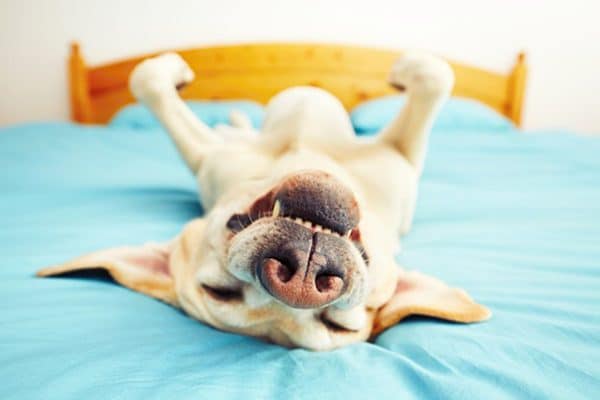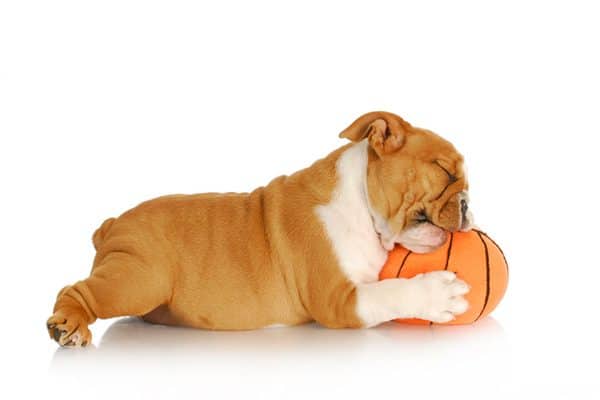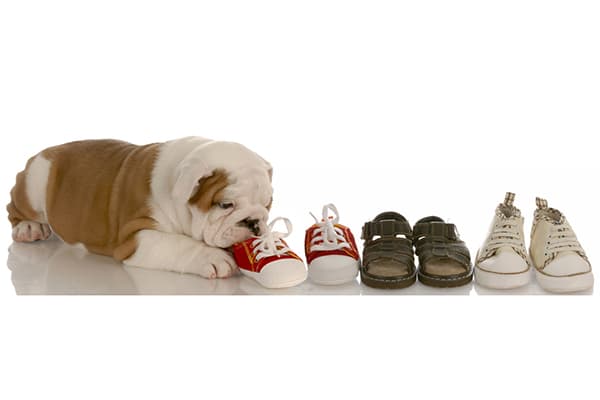There’s a meme out on the Internet that has a puppy pictured next to a velociraptor from the Jurassic Park movies. Under the puppy it says, “What I Expected,” and under the raptor, it says, “What I Got.” Now, your puppy isn’t about to hunt you down and eat you for breakfast, but when you’re dealing with puppy teething, the velociraptor description is surprisingly apt and probably has every dog parent wondering, “When do dogs stop teething?”
Let’s find out all about how a dog’s teeth grow, what happens during puppy teething, when dogs stop teething and what you can do to avoid getting bitten and inadvertently teaching your dog bad behavior as your puppy teethes.
Dogs Grow Teeth in Sets Like We Do

Just like us humans, dogs grow two sets of teeth. Baby teeth come in first, followed by adult teeth. Unlike us humans, who take months and years to get all our teeth in, dogs do it in a matter of months.
In fact, your puppy’s baby teeth start coming in between 3 to 5 weeks of age, and all their baby teeth are full grown by the time they’re 8 weeks old.
Around age 4 to 6 months, the process starts all over again, with a dog’s adult teeth coming in.
How Many Teeth Does a Dog Have?
A puppy grows 28 baby teeth. Those include 12 incisors, 4 canines and 12 premolars, according to the Dogster article, What Age Do Puppies Lose Their Teeth?. In comparison to us humans, a puppy doesn’t have his baby teeth for very long. A month after he finishes growing them, your puppy starts losing his baby teeth.
Adult dogs have 42 teeth. Specifically, they have 12 incisors, four canines, 16 premolars and 10 molars. They don’t grow in all at once (check out some specifics on teething below), but all of your dog’s adult teeth are in by the time he’s 6 months old. These are the teeth he’ll have for the rest of his life.
You might be wondering where your puppy’s teeth end up during all this. Turns out, you might not ever find your puppy’s lost teeth. Oftentimes, a puppy swallows his own baby teeth. That’s kind of gross, but it’s nothing to be concerned about.
What you do need to be concerned about is if a baby tooth doesn’t fall out. According to Dr. Everett Mobley of Kennett Veterinary Clinic in Kennett, Missouri, sometimes an adult tooth comes in right behind a baby tooth, and two teeth are meant for one spot. “This is most common with the canine teeth, the fangs, and it’s not good,” Dr. Mobley writes in his blog, Your Pet’s Best Friend. “If you see permanent teeth coming in while the baby teeth are still there, it’s important to have those baby teeth extracted.”
When Do Dogs Stop Teething?
According to the article, What Age Do Puppies Lose Their Teeth?, this is a general timeline of when your puppy’s teeth come in. Check out the article itself for a full description of what each tooth type does for your dog.
Baby Teeth
- 2 to 3 weeks: Your puppy’s incisors come in.
- 3 to 5 weeks: Your puppy’s four canines emerge.
- 5 to 6 weeks: Your puppy’s premolars come in.
By 8 weeks of age, the full set of baby teeth have come in.
Adult Teeth
- Weeks 12 to 16, the adult incisors start coming in. The canines come in around this time, too.
- Weeks 16 to 20: Your dog’s premolars start coming in.
- Weeks 16 to 24: Your dog’s molars come in.
By 5 to 6 months of age, all of your puppy’s adult teeth should have come in.
Why Do Dogs Teethe in the First Place?

So, why do dogs grow two sets of teeth? In fact, why do we humans grow two sets of teeth? Turns out we both do it for the same reasons — dogs and humans start growing teeth as we start weaning off a mother’s milk and transitioning to solid food. Problem is, adult teeth are too big for our jaws at this age. So, until a child or a puppy’s jaws get a little bigger, baby teeth come in. Our baby teeth also act as a guide for how our adult teeth come in properly — it’s why we have big gaps between our teeth before our adult teeth come in. Our adult teeth grow in those spaces, and so do your pup’s.
Keeping Your Dog’s Teeth Healthy
You brush and floss your own teeth, and you have to brush your dog’s teeth, too. Cavities are rarely seen in dogs, but that doesn’t mean they can’t or won’t have dental problems.
So, how often do you have brush your dog’s teeth? According to the Dogster article How Many Teeth Do Dogs Have?, veterinarians recommend daily brushing. Not all dogs will tolerate that, so author Melvin Peña writes, “You should try to brush [your dog’s teeth] at least once a week, or, at the very least, once a month. The earlier you start a dog on a regular dental care regimen, the more likely he will tolerate it.”
Why Are Puppy Teeth So Sharp?
Let’s go back to the velociraptor description. Sharp puppy teeth are a throwback to the earliest dogs. As an ancient puppy transitioned from milk to solid food, he needed sharp teeth to tear into the meat his mom brought him.
Sharp teeth also have a social function, in that they teach your puppy how to interact with other dogs. This is called ‘bite inhibition,’ and puppies must learn that biting another puppy too hard while playing is bad. That’s according to this Dogster article, How to Train Your Puppy to Have a Soft Mouth. “Your pup will learn that he will get more play time if he is gentle with his friends,” author Cindy Bruckart writes. “Older dogs might give a scarier correction for obnoxious puppy biting, and most pups will want to avoid that in the future.”
Unfortunately, it’s often hard for our puppies to learn not to bite us hard, and it can take a while to get that lesson into their cute little heads.
How to Handle Puppy Teething
A puppy who’s teething likes to chew on everything, which usually means that you get chewed on, too. When my German Shepherd Dog, Forest, was teething, my arms and feet looked like they had gone through a shredder. Why did he feel the need to chew on everything — a.k.a. mostly me?
According to Jamie Hulan, CPDT-KA, a dog trainer in Sacramento, California, and a certified member of The Association of Professional Dog Trainers, when those puppy teeth come in, they hurt — just like a human baby’s teeth. “Your dog isn’t completely grown when his adult teeth come in,” she explains. “As his jaw moves and develops, the teeth are moving and it causes lots of aches and pains.”
Chewing on things helps ease those aches and pains, so you’ll want to protect your furniture and your fingers from a teething puppy. The best way to do that is to provide toys meant for chewing, like Kongs or Nylabones, Hulan says.
During this time, stop using your hands to interact with your dog, too, Hulan advises. She points out that since humans often use our hands to touch dogs and play with them, puppies see our hands as chew toys. Replace your hands with actual dog toys to help redirect this behavior.
“If you have a toy on hand, you can use it to interact with your dog so he doesn’t chew on your hands, pant legs or shoes,” Hulan says. “It also teaches your dog he’ll have fun if he chews on the toy, and it’s always important that training be fun.”
However, Hulan cautions not to give your dog a toy after he puts his teeth on you. Otherwise, “The dog thinks, ‘Hmm, how do I get my human to play with me? Oh, I know, if I bite them, I’ll get a toy,’” she explains. “Be proactive, and give him the toy first.”
What to Do If a Teething Puppy Bites You
So, what if a puppy bites you? The second a puppy puts his teeth on skin, you should stop playing and walk away from the dog, Hulan advises. You can also do what another puppy would do, which is let out a ‘yip’ sound.
“That makes the dog stop and look at you to see if he hurt you,” Hulan says. “You can then use that time to walk away from your dog, wait about 10 seconds and then return to playing with a toy. Eventually a puppy learns that if he puts his teeth on you, the playing stops.”
Tell us: Is your puppy teething? Got any puppy teething horror stories? How do you deal?
Read more about dog teeth on Dogster.com:
- 6 Natural Treats That Are Good for Your Dog’s Teeth
- Dog Tooth Infection Signs and Treatments
- How to Prevent Tooth Troubles at Every Stage of Your Dog’s Life
Plus, discover more ways to take control over puppy chewing on Whole Dog Journal >>
Jessica Pineda is a freelance writer who lives in Northern California with her two German Shepherds, Forest and River. Check out her dogs’ Instagram page at @gsd_riverandforest.
Featured Image Credit: John Mcallister | Thinkstock.





